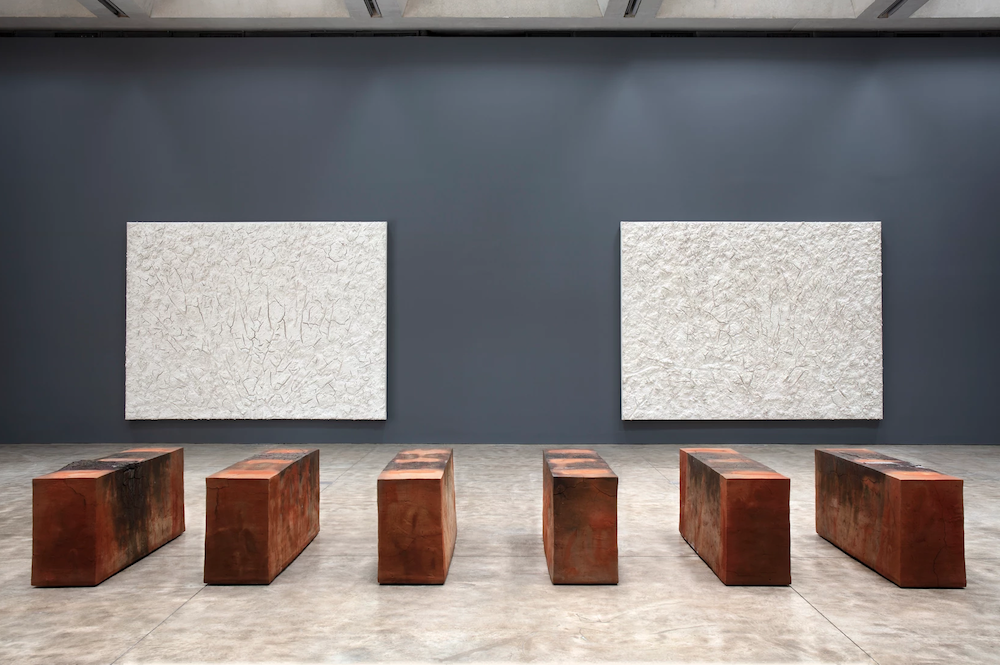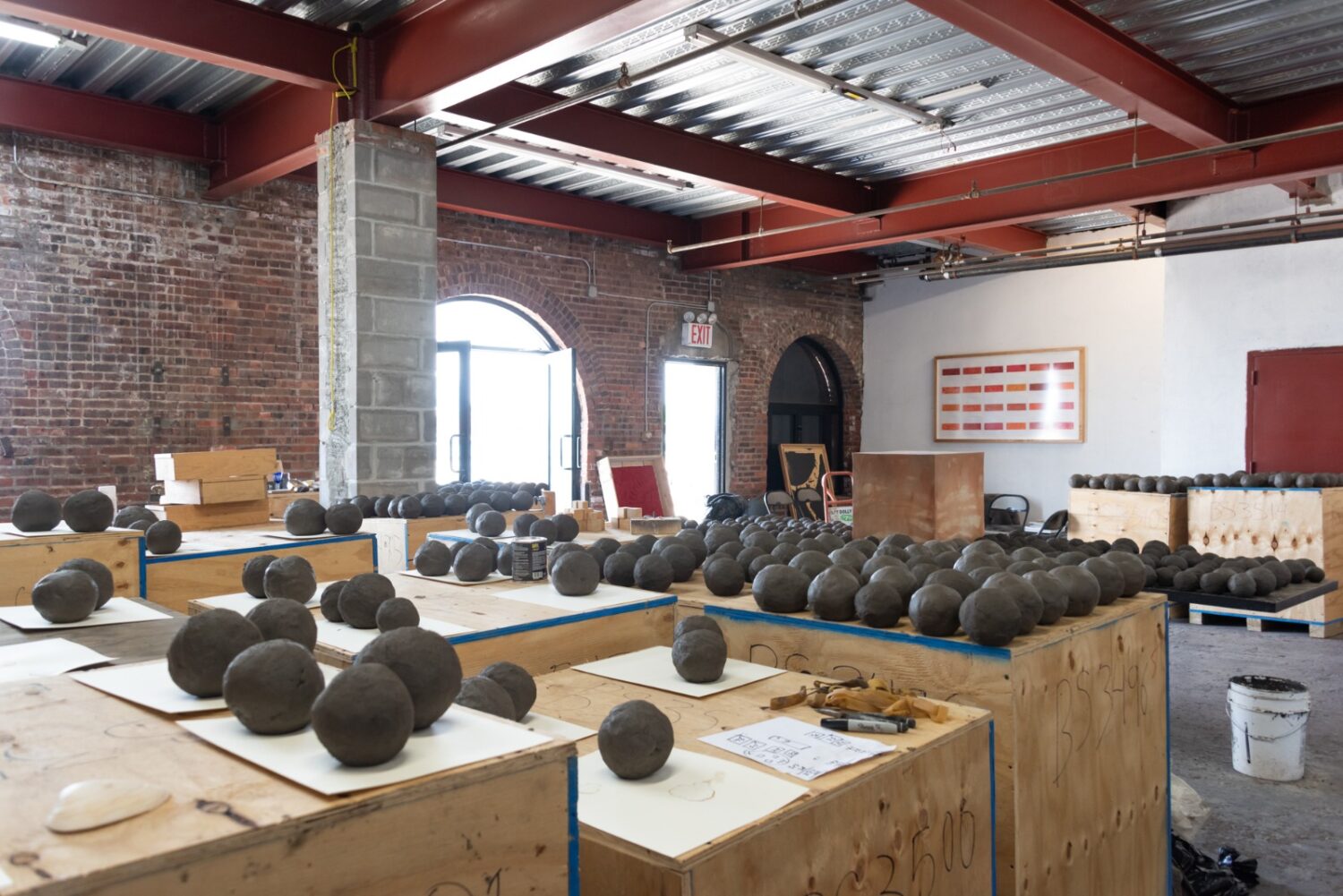New York–Kasmin’s exhibition of new work by Bosco Sodi (October 8–November 12, 2020) Vers l’Espagne is Sodi’s second solo exhibition at the gallery. Its title translates as “To Spain” in homage to the lineage of artists who influenced his early development as a painter. Drawing upon the evolution of art history from prehistoric cave painting through to modern Spanish artists Eduardo Chillida, Manolo Millares, Joan Miró, Antoni Tàpies, and Informalismo Catalan, Vers l’Espagneis a love letter to gesture, nature, and the artistic instinct.

The exhibition brings together five large-scale paintings with freestanding clay sculptures in the gallery’s flagship exhibition space. Entirely white, the restricted palette of the paintings develops the powerful simplicity of the raw, elemental materials—clay, sawdust, and pigment—that create the dense surfaces of the artist’s richly textured, monochromatic paintings. Sodi mixes the materials and throws them down onto a flat canvas in a gesturally energetic process that draws upon both creative intuition and chance. As the layers of material dry, structures form without the guidance or intervention of the artist, creating splintered ravines that recall primordial topographies and the fissured landscapes of his native Mexico.


In this series, Sodi calls particularly upon the work of Joan Miró and his three paintings titled Peinture sur fond blanc pour la cellule d’un solitaire (painting on a white background for the cell of a recluse) which are housed at the Joan Miró Foundation, Barcelona, where Sodi lived and worked for a decade. The atmospheric qualities of the color create, according to Sodi, “a feeling of warmth, calmness, and repose.” On Miró’s works, Sodi has said, “The paintings are just a thin black line made in a single gesture on a huge white canvas. I always admired them: wondering how Miró, with one stroke, was capable of doing something so powerful and beautiful.”


The exhibition coincides with the publication of a new career-spanning monograph published by Rizzoli, as well as several off-site and institutional projects including an exhibition featuring new black pigment paintings at CAC Málaga and a monumental sculpture Marble Muroat Casa Wabi, the artist’s foundation in Puerto Escondido, Oaxaca.

The Kasmin show is partnered by an exhibition sited on a once teeming commercial concrete parking lot two blocks south of Pioneer Works. Perfect Bodies speaks to, in artist Bosco Sodi’s words, “silence, contemplation and the passing of time—the small things in life and our relationship with the earth.” The installation consists of large-scale clay spheres and cubes made from local clay fired in the artist’s studio in Oaxaca, Mexico, which made the long journey by road across the Mexico-US border to Red Hook. A longtime resident of the neighborhood—itself named after the tone of its own clay soil—Sodi is known for his use of raw and organic materials to create textured paintings and objects.


Sodi’s ongoing dialogue with nature and landscape, shaped by his interests in Japanese aesthetics and Abstract Expression, puts himself in the lineage of both Arte Povera and Land Art—two post-war movements which emphasized, respectively, radically simple materials and an integral relationship between art and earth. As Spanish author Juan Manuel Bonet remarked in the artist’s 2020 eponymous monograph, his three dimensional works reconcile an interest in minimalism with the practices of Mexican heritage.


On this topic, curator Dakin Hart further writes:
At his place in Oaxaca, Sodi hand forms large geometric sculptures from clay and fires them in a makeshift kiln on the beach. Cuboids in different formats recall the scale and how-did-they-do-that-craft of cyclopean architecture across the ancient world. While spheroids, each formed by eye in a landscape of unbelievable things, might be the petrified remnants—or organic vanguard—of a Jurassic invasion. The past seeding itself into the present, a starting point for nature’s revenge.”
The third related program is an event from Studio Bosco Sodi and Kasmin, Tabula Rasa, a public artwork enacted over a single day on May 23, 2021, Tabula Rasa began at dawn in Washington Square Park, New York, with the installation of 439 small-scale clay spheres.


On view from 9am–1pm, the artwork began a second phase at 1pm, when New Yorkers passing through Washington Square Park took home a single clay sphere from the installation, a gesture which allows each person to become a part of the performance. At sunset, once each of the works has been claimed by the participating public, the performance came to close.


The clay spheres comprising the artwork will be handmade by the artist, symbolizing one day of the COVID-19 pandemic’s duration. Bringing indigenous Mexican agricultural practices to the United States, the spheres are vessels for new life, containing within them three types of seed—corn, squash, and bean—which sustain and nourish one another, finding an equilibrium that provides balanced sustenance. A potent metaphor for the necessity of cooperation and mutual assistance in times of need, these symbiotic plants encourage reflection on our own interdependence and reliance on both one another and also, crucially, on the natural world we inhabit.


Those who take the spheres home will be able to plant them in soil, activating another phase of the work during which the seeds will germinate and continue on into the cycle of life and death. Loaded with symbolism concerning new beginnings, transformation, and creative possibility, Sodi’s Tabula Rasa is an offering, a gesture that acts to bring together the diverse individuals that make up the city’s community as New York embarks on a second year of uncertainty and disruption.
Text and images courtesy Kasmin Gallery, Pioneer Works and Studio Bosco Sodi.

Add your valued opinion to this post.